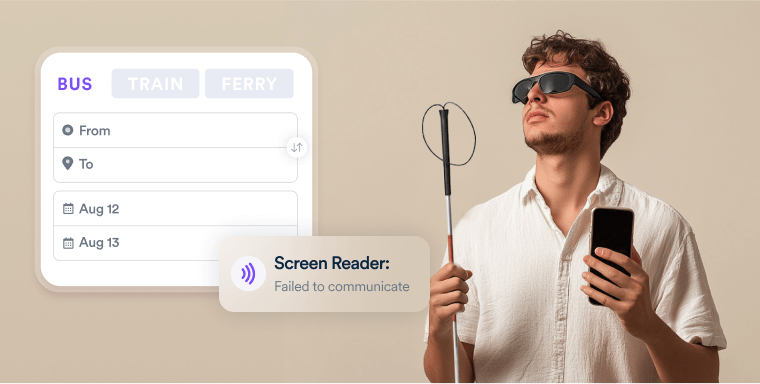The information presented within this guide is aimed at website owners seeking to learn the ropes of web accessibility and to create a more inclusive online environment for people with disabilities. Technical elements are described in layman’s terms, and, as a rule, all topics pertaining to the legalities of web accessibility are presented in as simplified a manner as possible. This blog has no legal bearing, and cannot be relied on in the case of litigation.
When was the last time you took hotel bed height into account when making vacation plans? Or have you ever had to consider which hiking trails you could reach without climbing a curb?
Whether or not these factors cross your mind, accessibility has long posed significant questions within the travel industry. accessiBe researched the increasing accessibility of travel—as well as its pain points in an increasingly digital world—to determine how to improve travel technology design for the future.
This is the third blog article in our ongoing series on accessibility within the travel industry. We encourage you to check out the first two installments:
- Why vacation rental property owners should care about web accessibility
- What should short term rental property owners do to become accessible right now?
Investing in accessibility for travelers with mobility disabilities

Those with mobility disabilities spend $58.2 billion on travel every year, according to a 2022 report by travel marketing company MMGY Global. Additionally, they take about as many trips in a year as those without mobility disabilities, often taking caregivers or family members with them as well. Thanks to the efforts of disability advocates across the country, popular destinations like Mesa, Arizona, and New York's Hudson Valley have invested in accessibility via wheelchair-friendly trails and better infrastructure surrounding top attractions. Several major cruise lines, including Princess Cruises and Carnival Cruise Line, have likewise tailored their amenities toward folks with limited mobility.
New travel agencies, founded to serve those with accessibility needs, are also working to improve the space.
"We decided that the traditional accessibility of the ADA was not enough," Joy Burns, alliance and community coordinator at Wheel the World, told Stacker Media. The platform maps over 200 data points such as the height of beds, circumference of a room, and turning space to determine how accessible a location is to travelers with disabilities.
Wheel the World is also part of another growing movement in travel: digitization. It's no secret that, much like the rest of our lives, the travel industry has increasingly moved online. According to analytics platform Data.ai, in 2023, smartphone users downloaded travel apps more than 3 billion times, and they spent nearly 16 billion hours on those apps, compared to 2.68 billion downloads and 12.66 billion usage hours in 2022.
Hotel reservations, flight tickets, day trips, dinner reservations—just about every aspect of vacation prep now happens on a screen. Even something as simple as ordering off a menu often requires scanning a QR code.
This shift toward digital trip planning has opened up new possibilities for travelers with disabilities. "In the past, when a person with a disability called a hotel, you'd get very basic information," she said. "Now, by digitizing all that information, you know exactly what to expect when you show up. It's given so much power and much more confidence to the traveler."
The downsides of digitalization and what companies are doing to improve

Though the increased digitization of travel has helped further accessibility in many ways, it has also brought about new issues. Those problems are often particularly apparent within the community of people with disabilities.
According to a 2021 Pew Research Center, Americans with disabilities are less likely to own digital devices. About 81% of U.S. adults without disabilities said they had a desktop or laptop, compared to 62% of Americans with disabilities. Similarly, 88% of U.S. adults without disabilities reported having smartphones compared to merely 72% of Americans with disabilities.
People with mobility challenges may struggle to hold a mouse, operate a keyboard, or read a screen, especially since website design often doesn't account for universal accessibility principles. In fact, the 2024 Web Accessibility in Mind report found that 95.9% of home pages failed to meet the organization's Web Content Accessibility Guidelines, which sets the standard for accessibility online. For example, checkout pages that "time out" after a certain amount of time has elapsed can add an extra layer of difficulty to travel planning. Taking additional steps like adding alternative text alongside images helps people with vision impairments understand the contents of a page better.
Some booking platforms and travel agencies have begun improving digital travel tools to combat these issues. That includes creating websites that people with vision impairments can easily use or designing travel apps based on feedback from individuals with disabilities.
Others offer round-the-clock phone assistance to those needing help navigating their site. In the era of chatbots and automated answering services, having a helpful, human voice on the other end of a phone call can go a long way toward making travel more accessible. But as Burns is quick to point out, these are simply starting points. Much more must be done—in both physical and digital spaces—to foster truly accessible travel experiences.
With so many different disabilities, "you can't say one size fits all because disability is so specific. I think digitizing all that information is the best way to make a better experience for the traveler," Burns said. In an increasingly digital world, even making that information available online would go a long way toward a more open, accessible world for all kinds of travelers.
